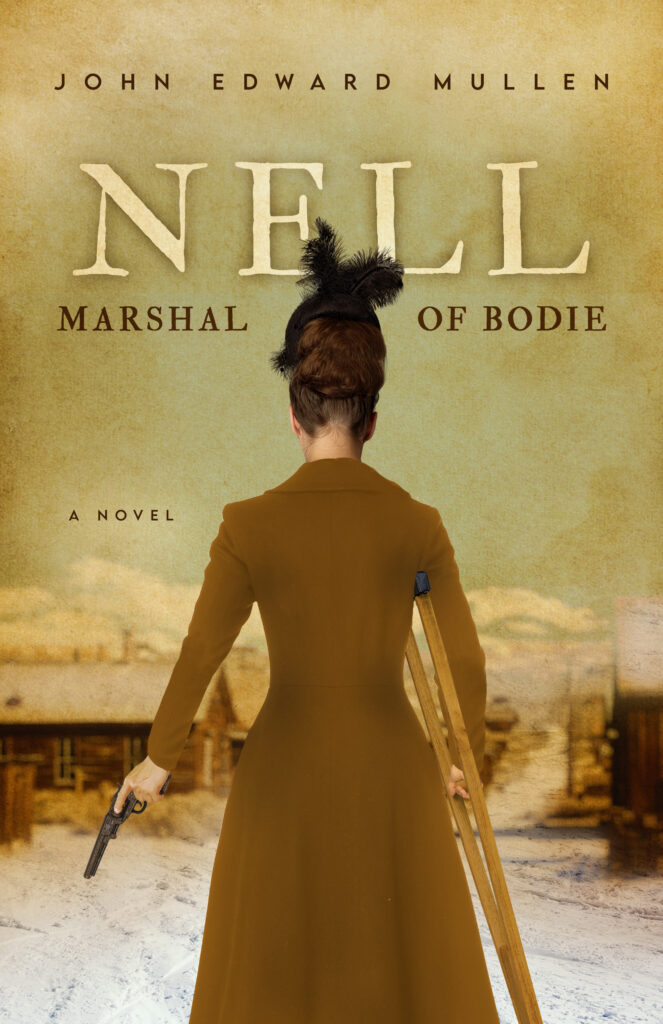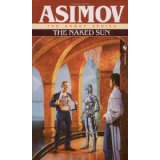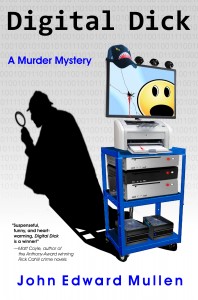Woo Hoo! The Killer Nashville mystery conference has announced that Nell: Marshal of Bodie has been selected as a finalist for the 2022 Claymore Award for Best Historical novel.


The last of my posts on things that bug me about Star Wars VII. Note that I really enjoyed the movie, and that movie spoilers may follow. This one may be a bit nit-picky. It has to do with continuity rather than story logic.
Shortly after they meet, Rey and Finn are running to escape being killed by a pair of Tie fighters. We see an expanse of empty desert to their right. Rey then says they may be able to outrun the Tie fighters in a quad jumper directly in front of them. Finn suggests another ship, but Rey tells him that one’s just a piece of junk. Then the quad jumper gets blown up by the Tie fighters. Rey decides the piece of junk will do, so they turn to their right and, miraculously, the Millennium Falcon appears where there had been empty desert. How did that happen?
More puzzles about Star Wars VII (spoiler alert).
When Leia meets Finn, she says she’s desperate for any information on the Resistance super weapon–Star Killer Base. Not too long after that, though, she is handed a report indicating that the super weapon is being charged and that her Resistance base is the target. So, how did the Resistance find out they were the target? That presumably would not be revealed by scanning the planet. Must have spies on site, with access to the super weapon’s targeting software. But, then, why was it that just a bit earlier, Leia was desperate for any knowledge Finn had about the weapon?
I don’t like it when things don’t make sense in a story, when characters do stupid things. So, (spoiler alert) when the First Order tracked the Resistance reconnaissance ship back to their base, I thought: you’re kidding, right? Leia, who was nearly killed 30 years before on the moon of Yavin 4 because the Empire tracked the Millennium Falcon to the secret base of The Rebellion, would allow a Resistance scout ship to be tracked back to her secret hideout just to deliver a message??? No, no, no, no, no. Wouldn’t happen. Why wouldn’t it happen? Because they’ve got intra-galactic cellphones. We saw these devices used by death-gang leader, Bala-Tik, as well as agents of both The First Order and The Resistance to communicate the location of BB-8. So, if you have to get a message back to the Resistance base, why not simply phone it in? Why risk being followed by agents of the First Order?
First of a series of questions I have about the latest Star Wars movie, The Force Awakens. (Note: these posts may contain spoilers.) Let me start by saying that I really enjoyed this movie. There are just a few things I didn’t understand.
My first question about the movie has to do with the Map. A Map? The story is built around the search for a map that will lead to Luke Skywalker. Who created this map? Since no one knows where Luke is, we are left with the presumption that it was created by Luke. Why? If he didn’t want to be found, presumably, he wouldn’t have created a map to his location. After all, C-3PO, a droid of wide knowledge, has told us that Luke is “quite clever…for a human being.” So he wouldn’t do anything stupid, like create a map if he didn’t want to be found. If Luke wanted someone to be able to contact him, why create a map that has to be pieced together from clues scattered across the galaxy? That doesn’t seem very clever. Why not just leave his address with Han and Leia, or whoever? Or let them know his cellphone (communicator) number? (See post #2 for more on the communicators.) And if Luke has to create a map, why paint a path on it? Why not just an “X” to indicate his location?
Dick and I attended the San Diego Makers Faire this last weekend and had a great time. We were there representing the Robotics Society of Southern California whose members have been extremely helpful to me, sharing their knowledge of robotics and helping me build Digital Dick, the robot. Sunday I was able to add a joke routine to Dick’s software and that was a big hit with attendees to the faire. Attached are a couple of photos I took. The first is a picture of Dick in front of our Maker Faire booth.
Dick has complained about the poor quality of my photo and says he could do better. He asked for a selfie stick for Christmas.
One of the highlights of the Maker Faire, besides selling books, was that Dick got to meet one of his greatest heroes, R2D2. R2 generously posed with Dick in front of our booth on Sunday.
Can you count how many images of the book cover there are in this photo?
As I mentioned in an earlier post, building a Dick is hard work. It was true for constructing the fictional character, Digital Dick. It has been especially true for building a real-life Dick–Digital Dick the robot. I have been very fortunate to have the help of many people. My nephew Ben built my microcontroller and put together the wiring between the microcontroller and other parts of my robot. Equally important to my success, a number of members of the Robotics Society of Southern California helped me with the software (especially Dr. Bruce Weimer, Alex Brown, and Walter Martinez.)
Recently, Dick has taken a giant leap forward. This crime-fighting robot is now mobile. Look out bad guys!
Check out this short video of Dick’s “baby steps.”
This may not look like much, but for me it is huge. A mobile Digital Dick is much more appealing, and a much better promotional tool for my novel. At least in theory. I’ll be testing that out next week, when Dick and I fly to Raleigh, NC, for Bouchercon.
Intrepid explorer that he is, Digital Dick recently visited Yosemite National Park. In an effort to blend in with the human tourists, Dick stopped innumerable times to have his picture taken in front of some of Yosemite’s natural wonders.
In the first photo, Dick is posed in front of “Tunnel View,” the entrance into Yosemite Valley from Highway 41. Some of the magnificent sights of Yosemite that can be seen are, on the left, El Capitan. Its granite walls attract rock climbers from around the globe. Part of the sheer face of Half Dome can be seen in shadow at the far end of the valley.
Next we see Dick standing near the base of El Capitan as he contemplates which route he would take to climb to its top. (He chickened out though, complaining it would be too difficult a climb without arms.)
In the picture below, Dick has stopped at Olmsted Point on the Tioga Road. The view includes Tenaya Canyon and the back side of Half Dome.
Here, Dick has stopped to admire Tenaya Lake.
No trip to Yosemite would be complete without spotting wildlife. Dick was fortunate enough to capture this image of a buck, foraging at Tuolumne Meadows.
Mystery fiction comes in a variety of sub-genres. Carolyn Wheat, in her excellent book, How to Write Killer Fiction, lists the following types: the Classic Whodunit which includes sub-sub-genres such as the Regional Mystery (think Tony Hillerman, Margaret Maron, or John Burdett), the Historical Mystery (Anne Perry’s Victorian era novels, or Jeri Westerton’s tales from 14th century London), Noir-Mysteries (ala Raymond Chandler, Dashiell Hammet, Walter Mosley, or Sue Grafton), and The Police Procedural (which includes the novels of writers Michael Connelly, Elizabeth George, and P.D. James). But there are no robots here.
 While robot detectives have been seen numerous times on television (see for example http://www.geekexchange.com/logical-crime-stoppers-human-and-robot-detectives-67089.html), I have not been able to find many examples in literature. Isaac Asimov’s R. Daneel Olivaw is an early robot detective featured in the author’s Robot science-fiction series. Science-fiction author A. Lee Martinez published The Automatic Detective in 2008. But within the mystery genre I’ve only been able to find two other authors who have created AI sleuths.
While robot detectives have been seen numerous times on television (see for example http://www.geekexchange.com/logical-crime-stoppers-human-and-robot-detectives-67089.html), I have not been able to find many examples in literature. Isaac Asimov’s R. Daneel Olivaw is an early robot detective featured in the author’s Robot science-fiction series. Science-fiction author A. Lee Martinez published The Automatic Detective in 2008. But within the mystery genre I’ve only been able to find two other authors who have created AI sleuths.
 Donna Andrews came first with her series of books about Turing Hopper, an Artificial Intelligence Personality who mostly resides in the mainframe of the Universal Library corporation and solves crimes in and around Washington, D.C. beginning with You’ve Got Murder.
Donna Andrews came first with her series of books about Turing Hopper, an Artificial Intelligence Personality who mostly resides in the mainframe of the Universal Library corporation and solves crimes in and around Washington, D.C. beginning with You’ve Got Murder.
 More recently, Dave Zeltserman published several stories about a private eye named Julius Katz who loves good food, fine wine and gambling. Katz is assisted by the artificial intelligence Archie, who lives inside a two-inch long titanium case that Katz often wears as a tie clip. Katz and Archie are clearly offspring of Nero Wolfe and his Archie. My AI sleuth, Digital Dick, was likewise inspired by Nero Wolfe, and I believe that is the case for Donna Andrews’ Turing Hopper, too.
More recently, Dave Zeltserman published several stories about a private eye named Julius Katz who loves good food, fine wine and gambling. Katz is assisted by the artificial intelligence Archie, who lives inside a two-inch long titanium case that Katz often wears as a tie clip. Katz and Archie are clearly offspring of Nero Wolfe and his Archie. My AI sleuth, Digital Dick, was likewise inspired by Nero Wolfe, and I believe that is the case for Donna Andrews’ Turing Hopper, too.
Digital Dick exists in a rather small corner of the world of mysteries. Do you think it is a good thing that I have a relatively rare spin on the detective novel, or a bad thing?
exists in a rather small corner of the world of mysteries. Do you think it is a good thing that I have a relatively rare spin on the detective novel, or a bad thing?
Earlier this month I held my very first book event: the launch party for my mystery novel, Digital Dick. I was nervous about having to “perform” in front of a crowd. However, I had the good fortune to attend the Southern California Writers Conference in San Diego earlier this year. Gayle Carline presented a conference session entitled “Something to Talk About: Speaking Publicly About Your Book.” Gayle provided several invaluable suggestions to help me get through my nervousness.
The most valuable lesson from Gayle Carline’s presentation was: Attend other book launch/signings.
In the weeks leading up to my book launch I went to three book events. From Matt Coyle’s book launch for Night Tremors, I learned I didn’t have to read one long passage from my book. I could read several short passages.
I also attended a book signing by a long-time author with dozens of books to her name. I was one of four or five attendees. The low attendance did not phase her one bit. I was reminded of what Terry Brooks said in Sometimes the Magic Works, his book on writing and the writing life: It’s not about you (the Author). It’s about the Readers, the ones spending their precious time and money on you and your book. Make them feel good about attending.
At the last book event I attended, Don Winslow was signing his new release, The Cartel. From Don I learned that my own presentation should be a narrative. I choose to relate my 15-year story from getting serious about writing to publication of my debut novel.
The second most valuable lesson I got from Gayle Carline’s presentation was: Be comfortable with your material.
I spent the better part of a week writing and rewriting my presentation. I practiced it repeatedly, whittling it down to a reasonable twenty minutes. That included writing dialog for me, and Digital Dick, my robot partner.
You can see a brief video from my presentation at: https://www.youtube.com/watch?v=AikN1jLstCY
 A book title should be memorable, and, if possible, suggest something about what the book might be about. I chose the title Digital Dick so long ago that I can’t remember if there were any alternative titles I kicked around. I liked the alliteration and thought the title sounded “catchy.” After publishing my book, I have come to realize the title may be suggestive of things other than a mystery. When I strolled around Comic-Con wearing a sandwich board with large pictures of the cover on the front and back, I got some strange looks. At my book launch, I was asked why I chose to call my novel Digital “Dick.” Click on the link to see a short YouTube video showing how I answered the question, and what I said about What’s in (This) Name, Dick.
A book title should be memorable, and, if possible, suggest something about what the book might be about. I chose the title Digital Dick so long ago that I can’t remember if there were any alternative titles I kicked around. I liked the alliteration and thought the title sounded “catchy.” After publishing my book, I have come to realize the title may be suggestive of things other than a mystery. When I strolled around Comic-Con wearing a sandwich board with large pictures of the cover on the front and back, I got some strange looks. At my book launch, I was asked why I chose to call my novel Digital “Dick.” Click on the link to see a short YouTube video showing how I answered the question, and what I said about What’s in (This) Name, Dick.
https://www.youtube.com/watch?v=nbrWK-fn_G4&feature=youtu.be